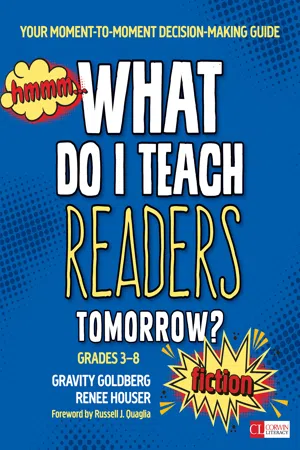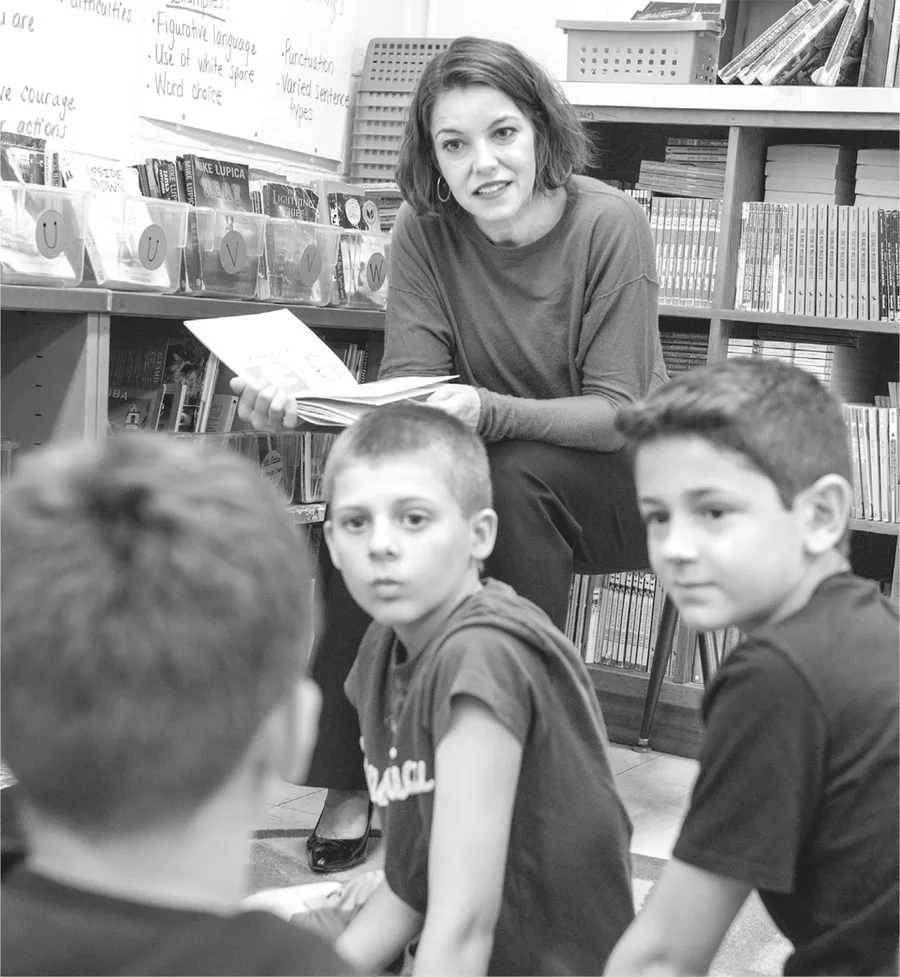![]()
1 Each Classroom Moment is an Instructional Decision
“The power of knowing, in that first two seconds, is not a gift given magically to a fortunate few. It is an ability that we can all cultivate for ourselves.”
(Malcolm Gladwell)
Justin paused at the front of the classroom and observed his students reading. Each student held a fiction book and was opening the pages and beginning to read. Some students had sticky notes out and were marking places, some students were rereading key parts, and some were revisiting the ideas they had already written down in notebook entries about the characters. Like most classrooms, some of Justin’s students were on grade level, many were a few levels behind, and a handful were well above or well below grade-level expectations. Students were reading series books, fantasy, and realistic fiction picture books, and some were reading the same books as their partners. While all of these students made choices about what and how to read, Justin took about ten seconds to scan his classroom, and then he stood up and began making decisions about what to teach each student next. There was no script or magic manual that told Justin whom to focus on in his daily small group work and conferences or what to teach them next. In each moment, Justin paused very briefly, took in the information he was gathering about his students, and made an intentional decision.
Like you, Justin makes literally hundreds of important decisions every day that flow from his mind into some kind of instructional action, fast and fluid as quicksilver. And if you are reading this book, we can probably infer you are wondering, “Am I making the right decisions?”
Malcolm Gladwell wrote the following description about improvisation in his best-selling book Blink: The Power of Thinking Without Thinking, but when we read it, we thought he was writing about being a teacher: “It involves people making very sophisticated decisions on the spur of the moment, without the benefit of any kind of script or plot. That’s what makes it so compelling and—to be frank—terrifying” (Gladwell, 2005, p. 113). While Gladwell popularized the term, thin-slicing was first cited in 1993 by Nalini Ambady and Robert Rosenthal in the Journal of Personality and Social Psychology, so it’s a concept with some legs.
As teachers, we are asked to make sophisticated decisions in every moment of the day. Larry Ferlazzo (2014) cited researchers Hilda Borko and Richard Shavelson’s (1990) findings that teachers make 0.7 decisions per minute during interactive teaching. Other research estimates as many as 2,000 decisions a day, a great number of them unplanned exchanges with students. The upshot for readers? We wrote this book because we want you to make those intuitive, improvisational exchanges count, and rooted in a foundation of what you think most supports readers. First, let’s turn to what Gladwell found in his research about these moment-to-moment choices and what we as teachers can learn from improvisers in the various fields he studied. We’ll learn more about how Justin was able to make such quick and powerful decisions about each of his students.
Acting Without a Script: Embracing Our Role as Improvisers
Teaching isn’t compared to Second City comedy very often, but think about it—it’s actually very similar. Improv comedy shows such as Whose Line Is It Anyway? on TV and numerous other live performances involve a group of actors working together without a script. There are no lines to memorize or stage directions to get your cues. It works like this: The first actor says a line, and then another actor has to decide who will go next and what to do and say. Since the parts are not preplanned, the actor has to react in the moment to what was just said and done, and help build the scene from there. Likewise, a student asks the teacher, “What does this word mean?” and she must decide what to say right there and then. Comedians are not the only improvisers, though; so are athletes. Many professions rely on a degree of improvisation. Think about the way in which emergency room surgeons must make a split-second decision as to how to treat a patient. Consider fine artists, who are not given directions for how to create their pieces of art, yet render meaningful images. And finally, picture the way a basketball player navigates the court, making split-second decisions. According to an article in Slate magazine, “Improvisational comedy workshops have become a staple at business schools, and in the corporate world in general,” and entrepreneurs are calling improvisation a “must-have” skill (Stevenson, 2014). As teachers, we are improvisers who act without a script, based on our moment-to-moment ideas about our students. We know you opened this book hungry to learn whether there is a good order to teach fiction structures and features, or how to plan the next day’s lesson based on today’s—but hang in there with this side-door entrance of ours, because it’s a powerful way to rethink your teaching self so that you can more easily redirect your fiction teaching.
Actively listening to our readers’ and studying their writing about reading is a sophisticated form of improv. This book teaches you how to develop this learned intuition.
© Andrew Levine
How Spontaneity Is Born
What Gladwell found in his research about what makes improvisers so successful has to do with breaking down some of our common beliefs about our decision-making practices. One of his claims is that spontaneity is not random, like many of us believe, but instead involves training, rules, and rehearsal. Those basketball players who look so fluid and spontaneous on the court can only do so because “everyone first engages in hours of highly repetitive and structured practice” (Gladwell, 2005, p. 114). Jazz musicians share similar experiences about their process. While the actual performance is improvised, it only works when each musician has first spent time learning to play well, keeps a consistent cadence, and listens attentively to others. Then the group of musicians can predict and quickly react to what each other will play to create an entertaining musical experience. One foundation for improv seems to be time spent practicing so you can make the rapid decisions in the moment. When Justin was able to walk over to a student, sit down, and decide what to teach next, he made it look easy, but it was based on countless hours of looking at student work, studying his own reading practices, and listening closely to what and how students discussed their books.
Another element of becoming a successful improviser is to know the “rules” of your field. In improv comedy, there is one main rule—always say “yes” and follow the lead of the person who came before you. In teaching students to read fiction, we have some rules or tenets we suggest you use when you are making instructional decisions, too; for example, only teach one skill at a time so students are not overwhelmed and have time to focus.
What all of these improvisers have in common is a focus on answering the question, “What next?” without the luxury of time to sit back and ponder the answer. “What chord should I play next?” “What move should I use to get around the opposing team’s player next?” “What skill should I teach this reader next?” Luckily, we don’t necessarily need as much time as we think we do when making our decisions.
When we listen to what students say about their thinking and really look closely, we can thin-slice and make quick yet powerful decisions about what to teach based on the readers right in front of us.
© Daryl Getman, DAG Photography
How “Thin-Slicing” Helps Us Make Decisions
As we said, one of the most memorable parts of Gladwell’s 2005 book Blink is the concept of thin-slicing, which “refers to the ability of our unconscious to find patterns in situations and behavior based on a very narrow slice of experience” (p. 23). Thin-slicing entails getting a very small amount of information and being able to use it to make a sound judgment and decision. Thin-slicing stems from what cognitive psychologist Gerd Gigerenzer calls being “fast and frugal” with our decision making. The part of our brains that can use small amounts of information to draw a conclusion is called the adaptive unconscious. It involves not overthinking and using our conscious effort to analyze information, but also using our “gut instincts” and our intuition about something in those first few seconds of being presented with information. Gladwell explains that adaptive unconscious is not the same as Sigmund Freud’s view of the unconscious and instead is seen as “a kind of giant computer that quickly and quietly processes a lot of the data we need in order to keep functioning as human beings” (p. 11).
Some examples of thin-slicing include art experts being able to know a forgery in the first few seconds of examination, tennis coaches being able to know whether the player will fault on a serve in the half a second before it is even struck, and a salesperson reading someone’s emotions and future decisions based on three seconds of observation (Gladwell, 2005). It is knowing something in just a few seconds—in the...



